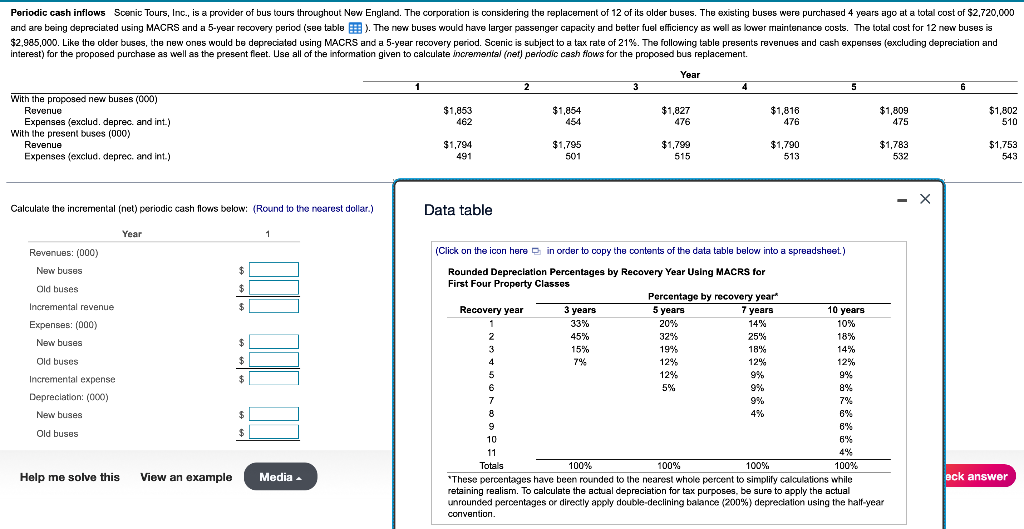
Periodic cash inflows Scenic Tours, Inc., is a provider of bus tours throughout New England. The corporation is considering the replacement of 12 of its older buses. The existing buses were purchased 4 years ago at a total cost of $2,720,000 and are being depreciated using MACRS and a 5-year recovery period (see table B). The new buses would have larger passenger capacity and better fuel efficiency as well as lower maintenance costs. The total cost for 12 new buses is . $2.985,000. Like the older buses, the new ones would be depreciated using MACRS and a 5-year recovery period. Scenic is subject to a tax rate of 21%. The following table presents revenues and cash expenses (excluding depreciation and interest) for the proposed purchase as well as the present fleet. Use all of the information given to calculate incremental (net) periodic cash flows for the proposed bus replacement. Year 1 2 3 4 5 6 $1,853 462 $1,854 454 $1.827 476 $1.816 476 $1,809 475 $1,802 510 With the proposed new buses (000) Revenue Expenses (exclud. deprec. and int.) With the present buses (000) Revenue Expenses (exclud. deprec, and int.) $1,794 491 $1,795 501 $1,799 515 $1,790 513 $1,783 532 $1,753 543 - X Calculate the incremental (net) periodic cash flows below: (Round to the nearest dollar.) Data table Year 1 (Click on the icon here in order to copy the contents of the data table below into a spreadsheet.) Revenues: (000) : () New buses $ $ $ $ Old buses Incremental revenue Expenses: (000) New buses $ $ $ Old buses Incremental expense Depreciation: (000) New buses Old buses Rounded Depreciation Percentages by Recovery Year Using MACRS for First Four Property Classes Percentage by recovery year Recovery year 3 years 5 years 7 years 10 years 1 33% 20% 14% 10% 2 45% 32% 25% % 18% 3 15% 19% 18% 14% 4 7% 12% 12% 12% 5 5 12% 9% 994 % 6 5% 9% 8% 7 9% 7% 8 4% 6% 9 6% 10 6% 11 444 Totals 100% 100% 100% 100% "These percentages have been rounded to the nearest whole percent to simplify calculations while retaining realism. To calculate the actual depreciation for tax purposes, be sure to apply the actual unrounded percentages or directly apply double-declining balance (200%) depreciation using the half-year convention. $ $ Help me solve this View an example Media eck answer Periodic cash inflows Scenic Tours, Inc., is a provider of bus tours throughout New England. The corporation is considering the replacement of 12 of its older buses. The existing buses were purchased 4 years ago at a total cost of $2,720,000 and are being depreciated using MACRS and a 5-year recovery period (see table B). The new buses would have larger passenger capacity and better fuel efficiency as well as lower maintenance costs. The total cost for 12 new buses is . $2.985,000. Like the older buses, the new ones would be depreciated using MACRS and a 5-year recovery period. Scenic is subject to a tax rate of 21%. The following table presents revenues and cash expenses (excluding depreciation and interest) for the proposed purchase as well as the present fleet. Use all of the information given to calculate incremental (net) periodic cash flows for the proposed bus replacement. Year 1 2 3 4 5 6 $1,853 462 $1,854 454 $1.827 476 $1.816 476 $1,809 475 $1,802 510 With the proposed new buses (000) Revenue Expenses (exclud. deprec. and int.) With the present buses (000) Revenue Expenses (exclud. deprec, and int.) $1,794 491 $1,795 501 $1,799 515 $1,790 513 $1,783 532 $1,753 543 - X Calculate the incremental (net) periodic cash flows below: (Round to the nearest dollar.) Data table Year 1 (Click on the icon here in order to copy the contents of the data table below into a spreadsheet.) Revenues: (000) : () New buses $ $ $ $ Old buses Incremental revenue Expenses: (000) New buses $ $ $ Old buses Incremental expense Depreciation: (000) New buses Old buses Rounded Depreciation Percentages by Recovery Year Using MACRS for First Four Property Classes Percentage by recovery year Recovery year 3 years 5 years 7 years 10 years 1 33% 20% 14% 10% 2 45% 32% 25% % 18% 3 15% 19% 18% 14% 4 7% 12% 12% 12% 5 5 12% 9% 994 % 6 5% 9% 8% 7 9% 7% 8 4% 6% 9 6% 10 6% 11 444 Totals 100% 100% 100% 100% "These percentages have been rounded to the nearest whole percent to simplify calculations while retaining realism. To calculate the actual depreciation for tax purposes, be sure to apply the actual unrounded percentages or directly apply double-declining balance (200%) depreciation using the half-year convention. $ $ Help me solve this View an example Media eck







